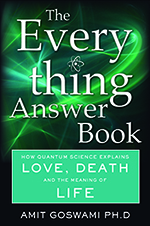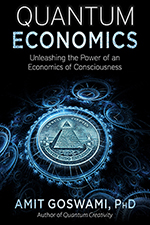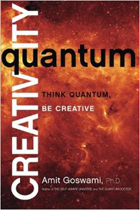A New Paradigm for Education: What Quantum Physics Tells Us About How We Should Educate Our Kids
By Amit Goswami, PhD
It may sound too theoretical, but it is a fact that how we educate our kids depends on the prevalent worldview of the educational establishment. And right now, that worldview is scientific materialism—the idea that everything is reducible to matter and its interactions. Corollary to this view is the Newtonian idea that we are mechanical machines. Accordingly, for the past 35-40 years, yes that’s how long this worldview has dominated academia; we have developed an educational system that treats human beings as machines.
To be sure, this approach is not a total mistake. Human beings do have a mechanical aspect. By emphasizing the three R’s—reading, writing, and arithmetic, the current school education does prepare students to do the basic tasks they need to hold a routine job appropriate for a blue-collar worker.
So what is wrong with this picture? The problem is human beings are not just machines; they are conscious, and consciousness is anything but mechanical. Machines are reducible to their parts, but consciousness is an irreducible whole. In this irreducible whole, there is room for both the physical/mechanical and nonphysical/non-mechanical. In this, we human beings are different from mechanical machines by having “internal” experiences—internal and subjective. It is this subjective, experiential, non-mechanical aspect of us that has created what we call civilization.
Human subjectivity is crucial to recognize and value. This is what makes every human unique. The principle of homogeneity holds only for machines. Thus, the current objective model of education—the same education fits all—is quite inadequate for educating human children.
Why do we do it then? Well, the political reason is that it helps elitism. It helps to create an elite group who can be trained in private schools and get very specialized education to rule over the rest of us. Just like the olden days. Yes, that is the way it was under feudalism! And oh, how some of our political leaders would love to embrace the good old days.
A little history will help. After feudalism, we did not jump into a mechanistic/materialistic worldview right away. We had a worldview called “modernism” for a few centuries. And in spite of many conceptual quandaries, modernism did give us three gifts that help grow civilization: democracy, capitalism, and liberal education.
Under feudalism, religious hierarchies dominated education. Religions originated from some very conscious ideas based on real people’s real experience. Ideas such as there is unity behind human diversity; ideas such as in order to move toward unity, we need to explore archetypal values such as love, beauty, justice, truth, and goodness etc.; ideas like if we pursue these archetypal values, our lives become meaningful like never before were explored by the spiritual. Unfortunately, in order to serve the elitist feudalism, religions themselves became corrupt and devalued people’s individuality. They taught dogma that ordinary people should follow.
Human beings battling against the religious dogma created modern science. Under modernism, we had liberal education for quite a while—dogma free education. The emphasis was on experience—try it and see for yourself. Truth is a pathless land, nobody can dictate it to you, etc., etc.
But this did not last. The philosophical inconsistencies of modernism eventually gave way to another dogma—scientific materialism. The dogma is this: there is nothing but the mechanistic part to the human being. Ignore the holistic and subjective stuff that do not fit the machine picture.
What is important to recognize is that compared to what went before, the mechanistic view has brought us much power and control over nature. It has given us modern technology; it has given us genetic biology and neuroscience. It has unveiled where our “evil” nature comes from—the negative emotional brain circuits. It has enabled us to develop quick fix remedies for our negativity—positive psychology. These are no mean feats.
But human potential goes further, much much further. And nothing attracts our attention to this faster than the realization that the jobs that a 3-R oriented education prepares us for now can be done much better by mechanical machines—robots. Indeed the biggest challenge of capitalism today is not, as some misguided politicians claim, trade deals. The biggest challenge is how to create jobs for humans that cannot be done by machines!
And more challenge: what do these non-mechanical jobs entail? The answer has been with us since the dawn of civilization: values and the meaning they give our lives! And that brings us back to square one. How to change our educational system in a manner that will prepare human beings for these non-mechanical jobs?
The Quantum Worldview
As I said before, how we educate our children depends on our worldview. As the shortcomings of materialism are being exposed, the worldview is changing too. Almost a century ago, Newtonian physics was replaced by a new physics called quantum physics. Newtonian physics has given us some dogmas about movements and interactions in the world. One dogma is the dogma of continuity—all movement is continuous. Another dogma is locality: all interactions and communications are local, taking place via signals moving little-by-little through space taking a certain time. Another one is determinism—where an object ends up when can be completely predicted.
Well, quantum physics is saying from the get-go that these are dogma, approximately true especially for the macro-world where we live but not gospel truth. And for the micro-world of elementary particles to which the macro reduces to in the final reckoning, these dogmas break down so completely that we have to invoke the new physics of quantum physics to understand things.
At the heart of the new physics is this realization: An object is both wave and particle. “How can it be that way?” you might ask. Don’t waves spread out having the capacity of being at more than one place all at the same time? And isn’t it true that particles have opposite behavior? They can only be in one place in a given time, right? When they move, don’t they move in a well-defined trajectory?
All true. Wave behavior and particle behavior are not compatible in any easily rationalized manner. But quantum theory says so, and experimentally, it is that way. So it was argued, rationalize we must. And the rationalization was called the principle of complementarity: quantum objects are both waves and particles, but you can measure only one aspect at a time! Although strictly not true (so there were always whispers to the contrary), most physicists went along with this rationalization. It is revolutionary enough, we thought. At least, we have replaced the Newtonian either/or by a more liberating both/and philosophy!
But there is a better way, and a more faithful way, to interpret the quantum math of wave-particle duality. Quantum math is straightforward: it just says quantum objects are waves. Period. Where do these waves move? Quantum math says they are waves of possibility; they move not in space-time but a domain outside of space and time called the domain of potentiality.
Does such a domain outside of space and time exist? Can it? Einstein and a couple of his collaborators proved with math that quantum objects do a “weird” thing that contradicts relativity theory according to which nature has a finite speed limit. Instead, said Einstein, “correlated,” quantum objects can communicate instantly. And then, all hell broke lose when the French physicist Alain Aspect and his collaborators experimentally demonstrated the truth: quantum objects, when correlated, can indeed communicate instantly! We call such communication nonlocal.
Is relativity theory wrong then? To save relativity theory, we must accept this: correlated quantum objects communicate instantly using the domain of potentiality, which is outside space and time and outside the jurisdiction of relativity theory.
It does make sense to talk about a domain of potentiality where quantum objects move as waves, where they communicate instantly but in potentiality. When we measure quantum waves of possibility, they reveal themselves as localized particles. This is the correct interpretation of quantum wave-particle duality.
The discovery of nonlocality certainly breaks down the dogma of Newtonian physics and scientific materialism that hold that there is only one domain of reality, space and time! But what is revolutionary about that? Think. Who talk about other domains of reality? It is the mystics—the founding fathers of religions. That’s who. They use different names to be sure—heaven and earth, transcendent and immanent worlds. But a rose by any other name…
Who else talk this way? The baroque artists and architects do, as well as the romantic poets.
Who else? Freud and Jung, the precursors of modern depth psychology who divided reality into two domains—conscious and unconscious.
Ah, so. Quantum physics is a giving scientific basis to religions (at least to some aspects of it), the arts, and the psychology of the unconscious.
For the scientific materialist, there is still a way out. Suppose this nonlocal domain has no teeth, no causal power. Now mind you, this is not what religions, artists, and Freudians say. Religions say heaven’s causal power comes from God’s downward causation—God’s power over us humans on the judgment day. Artists say their creativity is the gift of God’s downward causation. And Freud said the unconscious determines much of our “neurotic” behavior.
Quantum physics agrees with the religions, with the artists, and with Freud. What converts the waves of possibility into particle actualities? It must be downward causation from the domain of potentiality says quantum physics. Otherwise, we get paradox.
One good idea leads to another. When we go through the details of the conversion of waves into particles in a quantum measurement, which must include an observer, we come to the unmistakable conclusion: the domain of potentiality is consciousness. Our consciousness in its highest (or deepest) level is nonlocal, instantly interconnected. All objects of experience are waves of possibilities of consciousness itself; consciousness chooses one facet out of the many facets of a possibility wave to create actuality.
To cut to the chase, the theory of quantum measurement leads us to a legitimate scientific theory of both wholeness (when we are unconscious, not having experiences) and the separateness (when we are subjects looking at objects of experience). In this way, this theory also gives us a science of experience, all our experiences. Most importantly, the quantum worldview asserts that we create our reality in some sense. We can change in more than ornamental ways; we can be creative. We can transform and change from negative beings to more and more positive beings.
Quantum Education
So what do all these new revelations (or confirmation of old intuitions) entail for education? The following conclusions suggest themselves:
- Now that the quantum worldview is making subjective experience scientific, we must emphasize the importance of subjective experience in education once again. We have always known that this emphasis contributes to the students’ self worth and helps them build self-confidence. Also the homogeneity model (one size fits all) must give way to heterogeneity of the students.
- Whole is back; consciousness is a whole. So we must bring back aspects of holistic education without losing sight of the fact that matter is reductionist.
- Students therefore should continue to put emphasis on the 3 R’s but at once also emphasize the 3 I’s: Inspiration, Intuition, and Imagination.
- The arts, self-development, and social transformation should receive as much attention as science and math.
- Experiential learning must gain emphasis.
- Naturally, students will learn to value their intuitive experiences making room for imagination and creativity.
- With the scientific understanding of the creative process now at hand, all students can learn to be creative. No longer would we need to isolate the gifted and talented and give them special treatment.
- The quantum worldview brings back meaning and purpose. Education can stop being a preparation for routine jobs; instead, students can learn how to explore meaning and purpose of consciousness. They will then create their own meaningful and purposeful occupation. Doing so, they will become creative individuals in their own right and create a new society that they want to be a part of.



